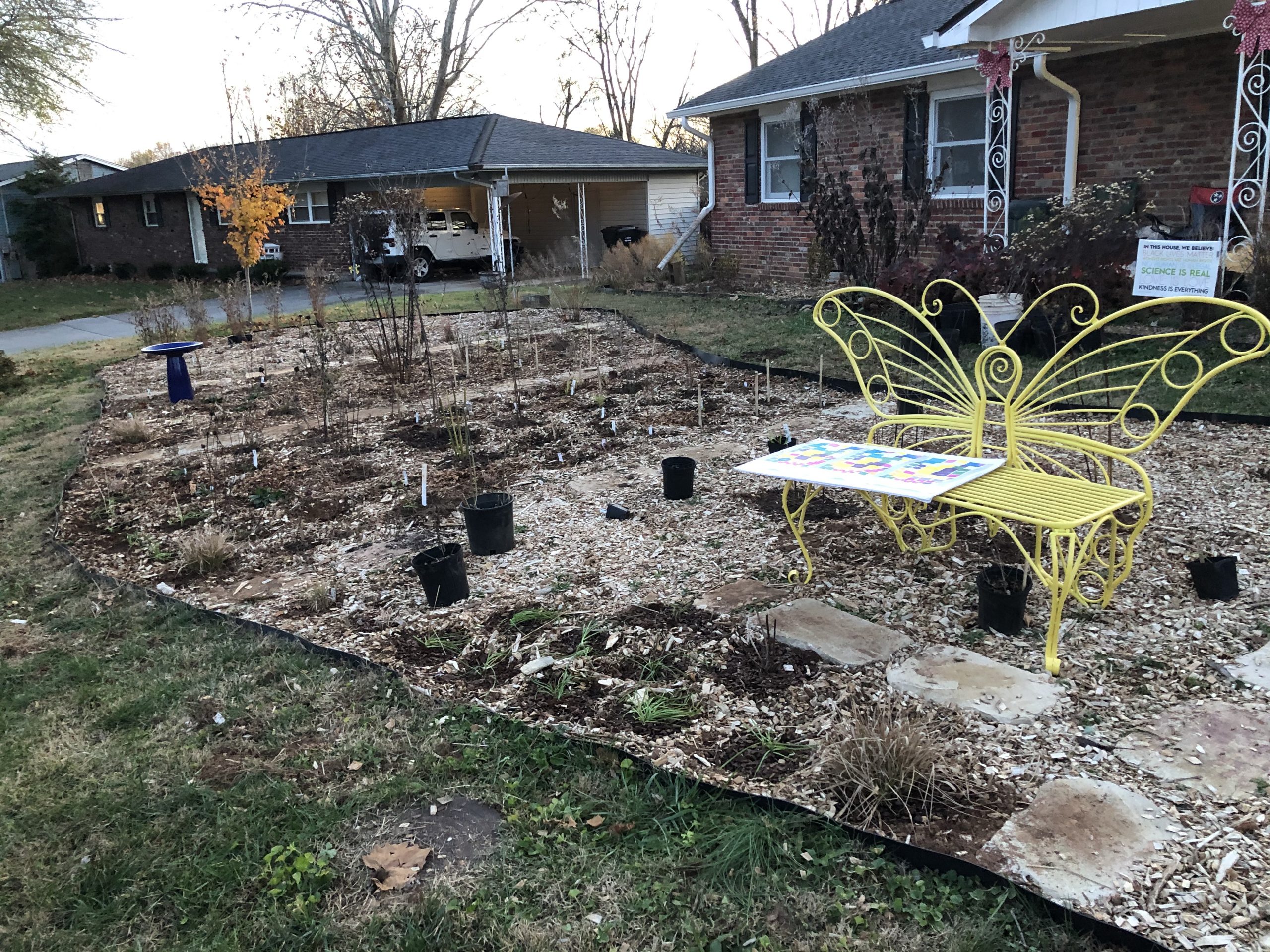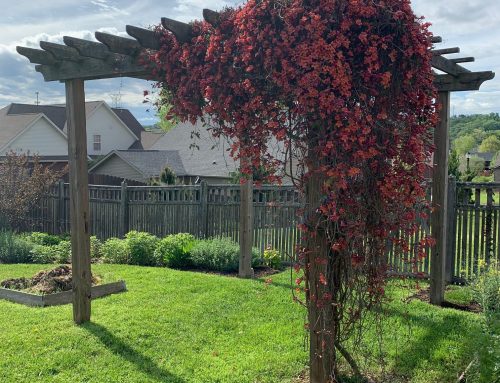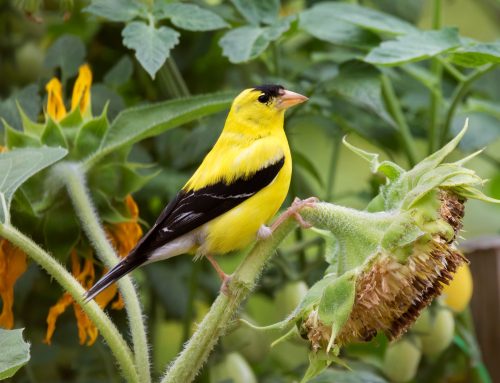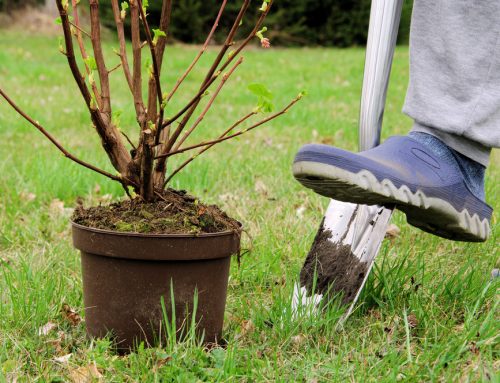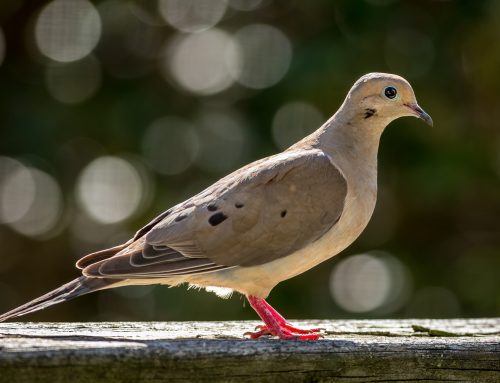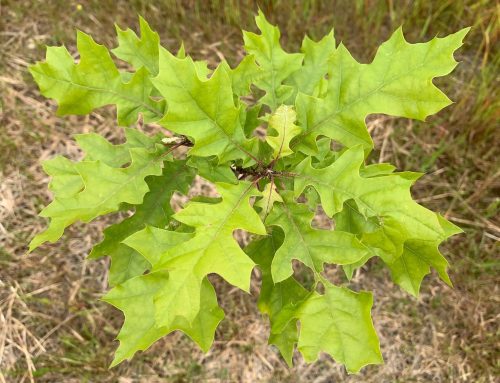by Karin Beuerlein
Fellow birders Angela Hoffman and Seth McConchie outdid all of us with their entry into the first KTOS Native Plant Challenge—they scored 217 points with a combination of trees, shrubs, and perennials. I’m here to give you a peek inside what they did and talk about how their garden has evolved over time to be more bird-friendly.
But first, I want to give everyone who participated a shout-out.
Kat and Rick Barrow: 80 points!
Kat says, “We started a native garden with bubbler rock pond when the pandemic began. For the challenge, we doubled the size and added native small trees and shrubs from Tennessee Naturescapes. Since we put in the native garden, we have seen such an increase in quantity and species of birds!”
They planted two Carolina buckthorn trees, five black chokeberries, one vernal witch hazel, two Virginia sweetspires, and four fothergilla shrubs.
Robin Nichols: 30 points!
Robin planted a white oak (snagging the only 20-point badge of our challenge!) and a dogwood.
Bill and Connie Keeler: 15 points!
(Bill says Connie gets all the credit.) They planted buttonbush, smooth viburnum, and sweetshrub from Overhill Gardens.
Morton Massey also had a project in the works that hit a snag, and he’ll take a second go at it in the spring.
So, counting the 35 points we started the challenge with plus Angela and Seth’s 217, that’s 377 total. We didn’t quite reach our goal of 500, but it’s a great start for the group. I hope that next time we’ll have more participants, and maybe some incentives. Every plant counts!
Angela and Seth’s Project
I spoke with Angela recently about her family’s Native Plant Challenge project, a front-yard garden that eliminated much of the lawn and replaced it with bird-friendly plants. (The final planting is shown in the top photo, ready to emerge in the spring.) They also expanded on existing garden areas with more perennials and shrubs.
KB: How did you first get interested in native plants?
AH: It really stems from our interest in birds. My spouse and I started birding back in 2003 when we were in graduate school at Purdue University, which has a great forestry and natural resources department and an active Audubon society. When we bought our first house here in Knoxville, we knew we should plant things that benefit the environment around us and create a place for birds to thrive. I’m a nature nerd, and I especially love detail, knowing all the Latin names of plants and so on.
KB: How did you get started? I know a lot of people are intimidated by taking that first step, especially when you say radical-sounding things like “eliminate your lawn.”
AH: Regarding our whole property, we’ve tackled it slowly over time. We did have to get rid of invasives first, and some silver maples that were threatening to fall onto our house.
We had a local native plant landscaper do an installation in our front and side yards in 2016. It was beautiful, but what I found was that if we don’t participate in the creation of a garden and invest the time in planting ourselves, we aren’t likely to take care of it. There’s a sense of ownership that comes from doing it yourself. As it was, our entire neighborhood is overrun with bermudagrass, and after a couple of seasons, the 2016 planting was overtaken by it. I thought I would be able to pull it by hand, but no.
KB: Bermuda is the absolute worst. I couldn’t possibly count how many hours I’ve spent pulling it out.
AH: We’ve found it at least 10 inches underground. It’s funny how triumphant you feel when you get an entire piece. It’s like a victory when you pull it out unbroken and it has the little point attached.
So that was part of the evolution of learning, having something get beyond our control and realizing how much work we truly needed to put in. We started redoing pieces of the yard ourselves, a bit at a time so we wouldn’t get overwhelmed. We’ve had a few additional designs done professionally since (click for an example), and then we’ve been implementing the designs ourselves at our own pace.
KB: For this fall’s project, how did you plan and prep the site?

AH: Since we were planning such a big installation, I built models. I didn’t have design software like AutoCAD or anything, so I built squares to scale in Word and dragged them around in a document. I had tried cutting circles out of paper and moving them around on a site map, but I was thinking, the second the cat walks by, this model is done for. Word is not technically built for that kind of thing, but it actually worked pretty well, and being able to modify my plan electronically was great.
I used a type of planting called matrix planting, which repeats patterns of plants, because creating five different sections each with its own design was too overwhelming. Matrix planting keeps a big garden from being too chaotic.
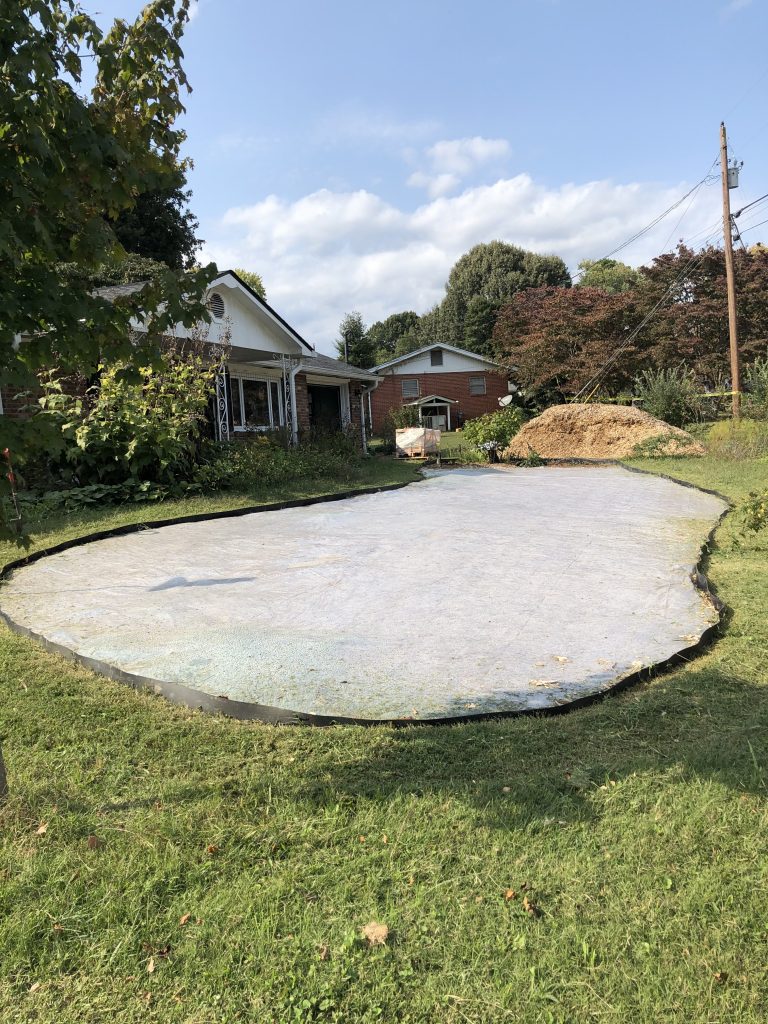
To prepare the ground to plant, we bought a big sheet of clear plastic on a roll from Lowe’s and solarized the bermudagrass to kill it entirely before we planted—meaning we covered it in clear plastic and let the sun cook it to death. We also installed 10-inch-deep edging all the way around, set in with a tree dibble, to make the sure the bermuda didn’t get back in. It was many, many hours of work—I won’t downplay that—but it felt good to do it the right way.
We felt confident about doing this 600-foot extension because we tried it on a small scale first. We had a 10’x10’ area that we solarized as a trial after we lost our first battle with bermuda. We used the edging in the same way and no grass encroached for two seasons, so we knew a bigger installation would be doable.
KB: And how did you choose plants?
Hours upon hours of reading books, reading blogs, reading websites, lovingly turning the pages of every native plant catalog I could find, and taking copious notes. I also spent a lot of time researching what is truly native to our local area and region using sources like the Biota of North American Program (BONAP) database.
I have plants in my garden from lots of different sources, but for this project I wanted plugs (small plants intended for bulk purchase), because with 200+ plants in the plan, it didn’t make sense to pay $10 per plant for quart sizes. So I sought out smaller alternatives, which set up faster anyway. My biggest source for this project was a New Jersey nursery called Pollen Nation, which has nice, healthy plugs for $3.50 and free shipping, which is hard to beat. I also got plants for certain species locally through Tennessee Naturescapes and Native Plant Rescue Squad and by mail order via Prairie Moon Nursery and Prairie Nursery.
KB: What are you looking forward to most in the spring?
AH: I can’t wait to see if the reality matches the vision I had; I’ve never designed something on this scale before. I know it will take two or three years to reach its peak, but we can already see little crowns emerging from where we planted in fall, and we’re very excited.
I’m also curious to see what the neighbors think. We spent dozens and dozens of hours in the front yard installing this project, and people walking by would see us and be curious about what we were doing. We’ve had lots of great conversations with people we wouldn’t talk to otherwise, and some have been very encouraging. One thing I did was get our garden certified through National Wildlife Federation, North American Butterfly Association, and Monarch Watch, so we’ll have signage that lets people know what this is really about.
KB: Any tips for people who want to get started on something like this?
Again, if you have bermudagrass, you have to completely commit to combatting it. You can’t go halfway. To that end, I recommend deep edging installed at the beginning of your project.
Also, if you’re new to this, do a small bed first to get your bearings. Small milestones are very satisfying, and on a small scale, each garden can make a difference. For example, we have a little downspout area that’s planted with swamp milkweed. We had dozens of monarch caterpillars there this year, and we were able to watch them with our five-year-old child.
It’s good to get a feel for what you can do, what you can take care of, and what your neighbors’ reactions will be, before you go too big. That way, you’ll take on only what you can handle, and it will make all the difference in whether you feel discouraged or successful in your efforts.
